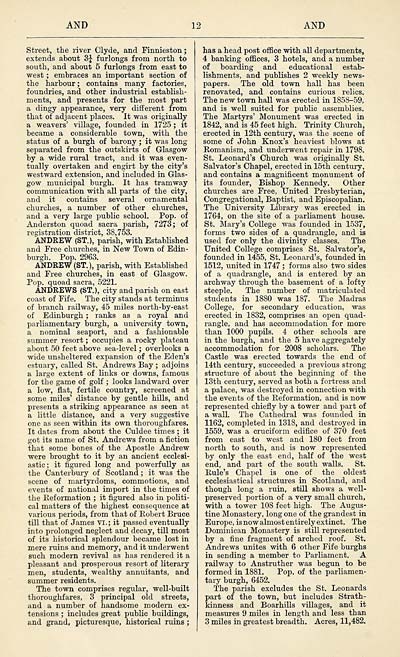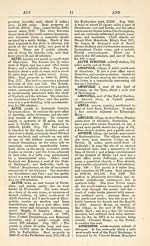Gazetteer of Scotland
(22) Page 12
Download files
Complete book:
Individual page:
Thumbnail gallery: Grid view | List view

AND
12
AND
Street, the river Clyde, and Finnieston;
extends about 3j furlongs from north to
south, and about 5 furlongs from east to
west ; embraces an important section of
the harbour; contains many factories,
foundries, and other industrial establish-
ments, and presents for the most part
a dingy appearance, very different from
that of adjacent places. It was originally
a weavers' village, founded in 1725 ; it
became a considerable town, with the
status of a burgh of barony ; it was long-
separated from the outskirts of Glasgow
by a wide rural tract, and it was even-
tually overtaken and engirt by the city's
westward extension, and included in Glas-
gow municipal burgh. It has tramway
communication with all parts of the city,
and it contains several ornamental
churches, a number of other churches,
and a very large public school. Pop. of
Anderston quoad sacra parish, 7273; of
registration district, 38,753.
ANDREW (ST.), parish, with Established
and Free churches, in New Town of Edin-
burgh. Pop. 2963.
ANDREW (ST.), parish, with Established
and Free churches, in east of Glasgow.
Pop. quoad sacra, 5221.
ANDREWS (ST.), city and parish on east
coast of Fife. The city stands at terminus
of branch railway, 45 miles north-by-east
of Edinburgh ; ranks as a royal and
parliamentary burgh, a university town,
a nominal seaport, and a fashionable
summer resort ; occupies a rocky plateau
about 50 feet above sea-level ; overlooks a
wide unsheltered expansion of the Eden's
estuary, called St. Andrews Bay ; adjoins
a large extent of links or downs, famous
for the game of golf ; looks landward over
a low, flat, fertile country, screened at
some miles' distance by gentle hills, and
presents a striking appearance as seen at
a little distance, and a very suggestive
one as seen within its own thoroughfares.
It dates from about the Culdee times ; it
got its name of St. Andrews from a fiction
that some bones of the Apostle Andrew
were brought to it by an ancient ecclesi-
astic; it figured long and powerfully as
the Canterbury of Scotland ; it was the
scene of martyrdoms, commotions, and
events of national import in the times of
the Reformation ; it figured also in politi-
cal matters of the highest consequence at
various periods, from that of Robert Bruce
till that of James vi. ; it passed eventually
into prolonged neglect and decay, till most
of its historical splendour became lost in
mere ruins and memory, and it underwent
such modern revival as has rendered it a
pleasant and prosperous resort of literary
men, students, wealthy annuitants, and
summer residents.
The town comprises regular, well-built
thoroughfares, 3 principal old streets,
and a number of handsome modern ex-
tensions ; includes great public buildings,
and grand, picturesque, historical ruins ;
has a head post office with all departments,
4 banking offices, 3 hotels, and a number
of boarding and educational estab-
lishments, and publishes 2 weekly news-
papers. The old town hall has been
renovated, and contains curious relics.
The new town hall was erected in 1858-59,
and is well suited for public assemblies.
The Martyrs' Monument was erected in
1842, and is 45 feet high. Trinity Church,
erected in 12th century, was the scene of
some of John Knox's heaviest blows at
Romanism, and underwent repair in 1798.
St. Leonard's Church was originally St.
Salvator's Chapel, erected in 15th century,
and contains a magnificent monument of
its founder, Bishop Kennedy. Other
churches are Free, United Presbyterian,
Congregational, Baptist, and Episcopalian.
The University Library was erected in
1764, on the site of a parliament house.
St. Mary's College was founded in 1537,
forms two sides of a quadrangle, and is
used for only the divinity classes. The
United College comprises St. Salvator's,
founded in 1455, St. Leonard's, founded in
1512, united in 1747 ; forms also two sides
of a quadrangle, and is entered by an
archway through the basement of a lofty
steeple. The number of matriculated
students in 18S0 was 187. The Madras
College, for secondary education, was
erected in 1832, comprises an open quad-
rangle, and has accommodation for more
than 1000 pupils. 4 other schools are
in the burgh, and the 5 have aggregately
accommodation for 2008 scholars. The
Castle was erected towards the end of
14th century, succeeded a previous strong
structure of about the beginning of the
13th century, served as both a fortress and
a palace, was destroyed in connection with
the events of the Reformation, and is now
represented chiefly by a tower and part of
a wall. The Cathedral was founded in
1162, completed in 1318, and destroyed in
1559, was a cruciform edifice of 370 feet
from east to west and 180 feet from
north to south, and is now represented
by only the east end, half of the west
end, and part of the south walls. St.
Rule's Chapel is one of the oldest
ecclesiastical structures in Scotland, and
though long a ruin, still shows a well-
preserved portion of a very small church,
with a tower 108 feet high. The Augus-
tine Monastery, long one of the grandest in
Europe, is now almost entirely extinct. The
Dominican Monastery is still represented
by a fine fragment of arched roof. St.
Andrews unites with 6 other Fife burghs
in sending a member to Parliament. A
railway to Anstruther was begun to be
formed in 1881. Pop. of the parliamen-
tary burgh, 6452.
The parish excludes the St. Leonards
part of the town, but includes Strath-
kinness and Boarhills villages, and it
measures 9 miles in length and less than
3 miles in greatest breadth. Acres, 11,482.
12
AND
Street, the river Clyde, and Finnieston;
extends about 3j furlongs from north to
south, and about 5 furlongs from east to
west ; embraces an important section of
the harbour; contains many factories,
foundries, and other industrial establish-
ments, and presents for the most part
a dingy appearance, very different from
that of adjacent places. It was originally
a weavers' village, founded in 1725 ; it
became a considerable town, with the
status of a burgh of barony ; it was long-
separated from the outskirts of Glasgow
by a wide rural tract, and it was even-
tually overtaken and engirt by the city's
westward extension, and included in Glas-
gow municipal burgh. It has tramway
communication with all parts of the city,
and it contains several ornamental
churches, a number of other churches,
and a very large public school. Pop. of
Anderston quoad sacra parish, 7273; of
registration district, 38,753.
ANDREW (ST.), parish, with Established
and Free churches, in New Town of Edin-
burgh. Pop. 2963.
ANDREW (ST.), parish, with Established
and Free churches, in east of Glasgow.
Pop. quoad sacra, 5221.
ANDREWS (ST.), city and parish on east
coast of Fife. The city stands at terminus
of branch railway, 45 miles north-by-east
of Edinburgh ; ranks as a royal and
parliamentary burgh, a university town,
a nominal seaport, and a fashionable
summer resort ; occupies a rocky plateau
about 50 feet above sea-level ; overlooks a
wide unsheltered expansion of the Eden's
estuary, called St. Andrews Bay ; adjoins
a large extent of links or downs, famous
for the game of golf ; looks landward over
a low, flat, fertile country, screened at
some miles' distance by gentle hills, and
presents a striking appearance as seen at
a little distance, and a very suggestive
one as seen within its own thoroughfares.
It dates from about the Culdee times ; it
got its name of St. Andrews from a fiction
that some bones of the Apostle Andrew
were brought to it by an ancient ecclesi-
astic; it figured long and powerfully as
the Canterbury of Scotland ; it was the
scene of martyrdoms, commotions, and
events of national import in the times of
the Reformation ; it figured also in politi-
cal matters of the highest consequence at
various periods, from that of Robert Bruce
till that of James vi. ; it passed eventually
into prolonged neglect and decay, till most
of its historical splendour became lost in
mere ruins and memory, and it underwent
such modern revival as has rendered it a
pleasant and prosperous resort of literary
men, students, wealthy annuitants, and
summer residents.
The town comprises regular, well-built
thoroughfares, 3 principal old streets,
and a number of handsome modern ex-
tensions ; includes great public buildings,
and grand, picturesque, historical ruins ;
has a head post office with all departments,
4 banking offices, 3 hotels, and a number
of boarding and educational estab-
lishments, and publishes 2 weekly news-
papers. The old town hall has been
renovated, and contains curious relics.
The new town hall was erected in 1858-59,
and is well suited for public assemblies.
The Martyrs' Monument was erected in
1842, and is 45 feet high. Trinity Church,
erected in 12th century, was the scene of
some of John Knox's heaviest blows at
Romanism, and underwent repair in 1798.
St. Leonard's Church was originally St.
Salvator's Chapel, erected in 15th century,
and contains a magnificent monument of
its founder, Bishop Kennedy. Other
churches are Free, United Presbyterian,
Congregational, Baptist, and Episcopalian.
The University Library was erected in
1764, on the site of a parliament house.
St. Mary's College was founded in 1537,
forms two sides of a quadrangle, and is
used for only the divinity classes. The
United College comprises St. Salvator's,
founded in 1455, St. Leonard's, founded in
1512, united in 1747 ; forms also two sides
of a quadrangle, and is entered by an
archway through the basement of a lofty
steeple. The number of matriculated
students in 18S0 was 187. The Madras
College, for secondary education, was
erected in 1832, comprises an open quad-
rangle, and has accommodation for more
than 1000 pupils. 4 other schools are
in the burgh, and the 5 have aggregately
accommodation for 2008 scholars. The
Castle was erected towards the end of
14th century, succeeded a previous strong
structure of about the beginning of the
13th century, served as both a fortress and
a palace, was destroyed in connection with
the events of the Reformation, and is now
represented chiefly by a tower and part of
a wall. The Cathedral was founded in
1162, completed in 1318, and destroyed in
1559, was a cruciform edifice of 370 feet
from east to west and 180 feet from
north to south, and is now represented
by only the east end, half of the west
end, and part of the south walls. St.
Rule's Chapel is one of the oldest
ecclesiastical structures in Scotland, and
though long a ruin, still shows a well-
preserved portion of a very small church,
with a tower 108 feet high. The Augus-
tine Monastery, long one of the grandest in
Europe, is now almost entirely extinct. The
Dominican Monastery is still represented
by a fine fragment of arched roof. St.
Andrews unites with 6 other Fife burghs
in sending a member to Parliament. A
railway to Anstruther was begun to be
formed in 1881. Pop. of the parliamen-
tary burgh, 6452.
The parish excludes the St. Leonards
part of the town, but includes Strath-
kinness and Boarhills villages, and it
measures 9 miles in length and less than
3 miles in greatest breadth. Acres, 11,482.
Set display mode to: Large image | Transcription
Images and transcriptions on this page, including medium image downloads, may be used under the Creative Commons Attribution 4.0 International Licence unless otherwise stated. ![]()
| Gazetteers of Scotland, 1803-1901 > Gazetteer of Scotland > (22) Page 12 |
|---|
| Permanent URL | https://digital.nls.uk/97355485 |
|---|

